MARIANI’SVirtual Gourmet
April 15,
20012
NEWSLETTER
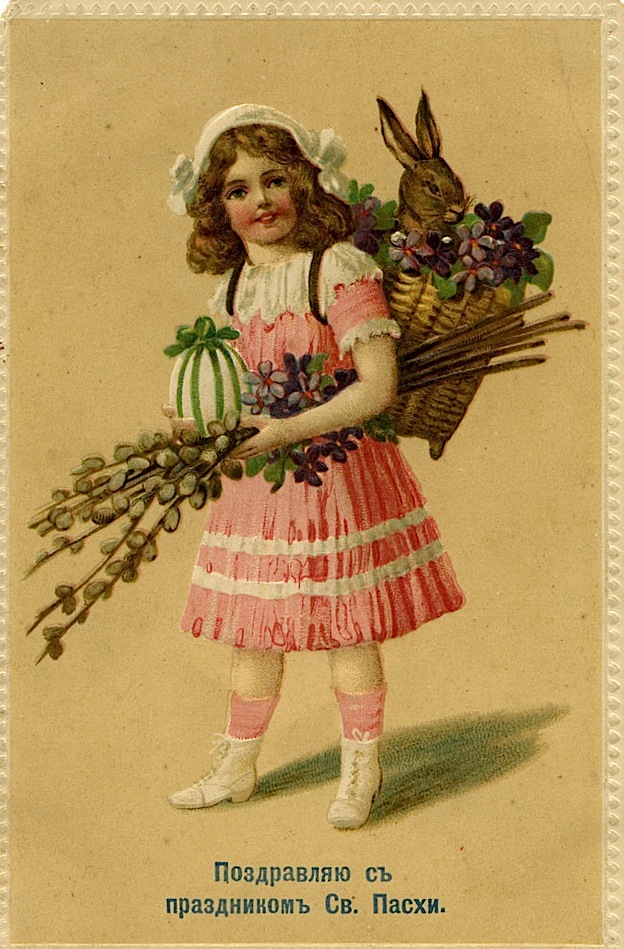
Russian
Easter Post Card
❖❖❖
ANNOUNCEMENT: On Wednesday, April 18, John Mariani will host a book signing dinner at Via Vanti restaurant at 2 Kirby Plaza in Mount Kisco, NY. Five-course meal at $85 per person, including signed copy of How Italian Food Conquered the World. Call 914-666-6400. Click here.
❖❖❖
THIS WEEK
by John Mariani
NEW YORK CORNER
Brasserie Pushkin
by John
Mariani
NOTES FROM THE WINE CELLAR
Calming Down Those California Pinot Noirs
by John Mariani
❖❖❖

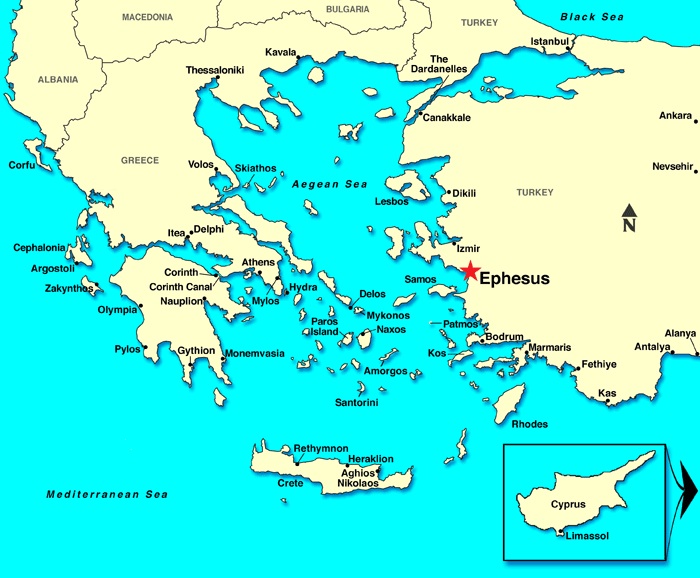 Kuşadasi is not on most
people's first destination stops in the Aegean,
unless you are an archaeologist, in which case it
would be the prime purpose of your visit.
Kuşadasi is not on most
people's first destination stops in the Aegean,
unless you are an archaeologist, in which case it
would be the prime purpose of your visit.
Kuşadasi's history is as ancient as
any in the Middle East, dating back to 3000 B.C., the
end of the Neolithic Period, a time when the legendary
city of Troy was said to have been founded and when
Stonehenge was begun. Today its most historic site is
the broad ruins of Ephesus, one of the glories of
Aegean archaeology, a huge expanse of temples and
markets built on over milennia by the Leleges,
Aeolians, Lydians, Persians, Greeks, Romans and
Christians.
From 1086 on, Kuşadasi, called
bird’s island, became Turkish, an important stop along
the trade routes from which to sell and ship goods. The
caravans had stops every 25 miles or so--the distance
a camel can travel in a day--where a caravansary, some
quite large and elegant, were built. You can still
visit the 300-year old inn, the Kervansaray
Club (the
fortress-like structure in the photo above),
now a hotel, on Ataturk Road.
Soon after World War I the city was
captured by the Greeks and not returned to Turkish
rule until 1922; its location and good weather have
made it a tourist destination since the end of World
War II, but it’s never been overexploited, so that the
thousands who roam the ruins of Ephesus are largely
day trippers who have gotten off the cruise ships.
Kuşadasi’s most visited spots
include a Castle built by the Genöese, now, oddly
enough, a disco, and the two-domed 14th
century Isa Bey Cami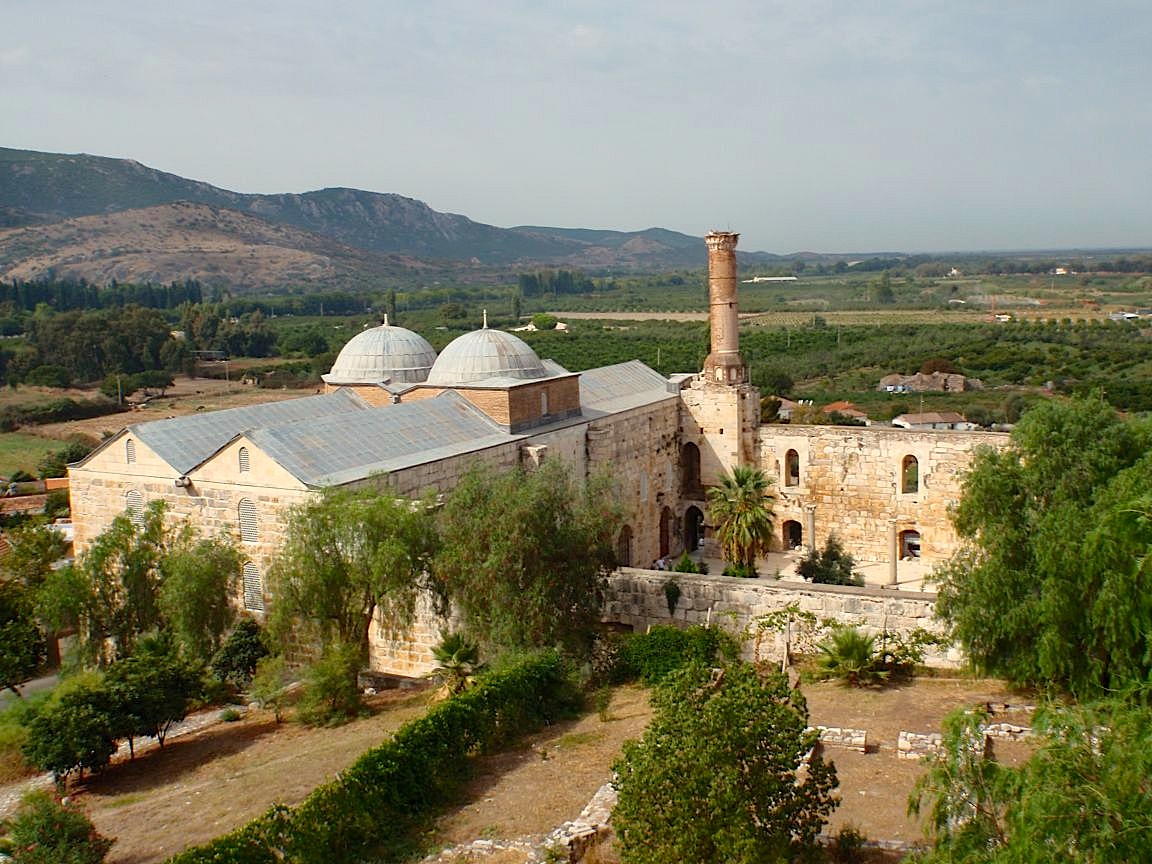 mosque (right). St.
John Basilica, built by the emperor Justinian and said
to hold St. John the Evangelist’s body, is now
but a ruin, after being destroyed by an earthquake. Yet, within
its open-air site, in the shape of a cross, you can
still readily admire the elegance of its slender
columns, the keyhole shape of the Baptistry, and the
remains of 10th century
frescoes.
mosque (right). St.
John Basilica, built by the emperor Justinian and said
to hold St. John the Evangelist’s body, is now
but a ruin, after being destroyed by an earthquake. Yet, within
its open-air site, in the shape of a cross, you can
still readily admire the elegance of its slender
columns, the keyhole shape of the Baptistry, and the
remains of 10th century
frescoes.
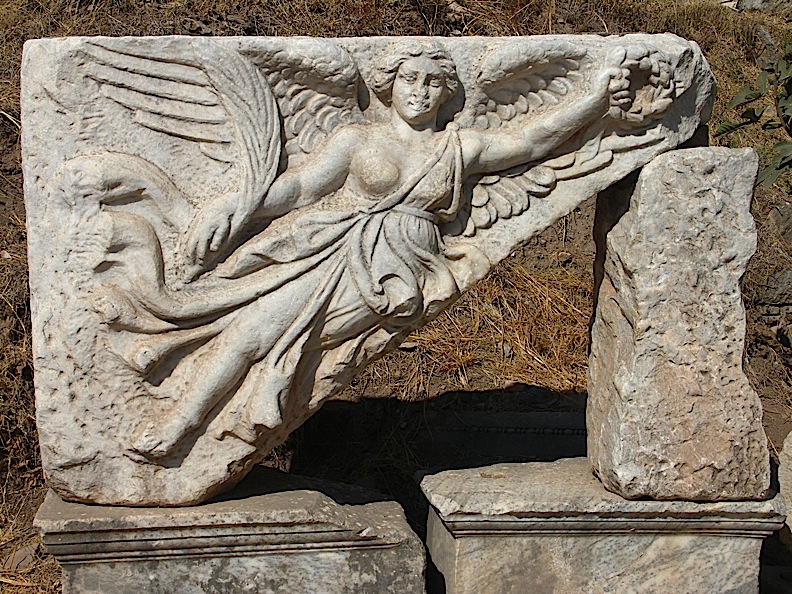 Ephesus
itself (left),
which has been undergoing some major excavation and
stabilization work, contains the column of what
remains of the Greek Temple of Artemis, once famous as
one of the Seven Wonders of the Ancient World. The
site also has an extraordinary, huge stadium that sat
70,000 spectators and once served for gladiatorial
combat, and a theater (below) that held 25,000 people,
still used today for performances of drama and dance.
Poetry readings were held at the odeon. The Library of
Celsius has enough intact to indicate how beautiful
Ephesus once was, and for an impressive view of a
Roman residence, you can now climb secure walkways in
and around the Terrace House, whose interior frescoes
are still in very good shape. From the great Gate
of Ephesus the road is lined with columns from and to
which travelers and traders would come and go for
centuries.
Ephesus
itself (left),
which has been undergoing some major excavation and
stabilization work, contains the column of what
remains of the Greek Temple of Artemis, once famous as
one of the Seven Wonders of the Ancient World. The
site also has an extraordinary, huge stadium that sat
70,000 spectators and once served for gladiatorial
combat, and a theater (below) that held 25,000 people,
still used today for performances of drama and dance.
Poetry readings were held at the odeon. The Library of
Celsius has enough intact to indicate how beautiful
Ephesus once was, and for an impressive view of a
Roman residence, you can now climb secure walkways in
and around the Terrace House, whose interior frescoes
are still in very good shape. From the great Gate
of Ephesus the road is lined with columns from and to
which travelers and traders would come and go for
centuries.
For many, the legend that the
Virgin Mary lived in Kuşadasi is good reason to pay
homage at her house (below),
whose parking lot is now packed during the season with
tour buses.
Pilgrims pin their prayers to a wall set up here,
and there are plenty of religious geegaws to be
bargained for. Yet the house itself is very
pretty, very calm, and it is from here it was said
that Mary's virginal body ascended to heaven from this
quiet, once secluded spot in the cypress hillsides.
For more mundane excursions there
is shopping in downtown Kuşadasi, including Turkish
carpets and jewelry, and, this being Turkey, haggling
with the seller is expected. Euros and
dollars are accepted pretty much everywhere, though
the exchange rate is never in your favor.
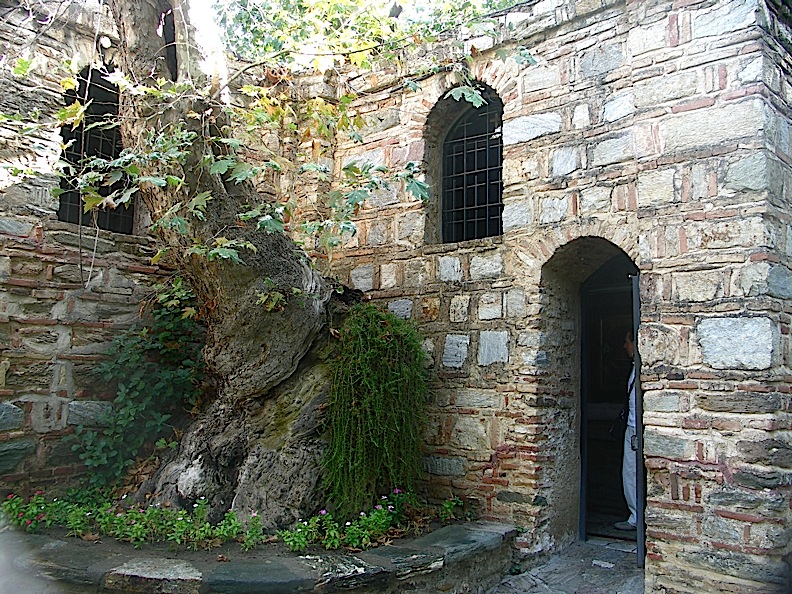 The food of Kuşadasi is basically
Turkish, with influences from Greece, and close
to the Middle Eastern models of mezes, excellent
fish, and sweets. There are other cuisines in the
city, but why a visitor of short duration would want
to go to a place called Yucca Mexican-Chinese-Turkish
Restaurant or Michael’s Steak House is beyond me.
The food of Kuşadasi is basically
Turkish, with influences from Greece, and close
to the Middle Eastern models of mezes, excellent
fish, and sweets. There are other cuisines in the
city, but why a visitor of short duration would want
to go to a place called Yucca Mexican-Chinese-Turkish
Restaurant or Michael’s Steak House is beyond me.
Typical but
considered one of the best traditional restaurants in
the town of Selçuk is Selçuk
Köftecisi, an unprepossessing eatery off the main
track, with a cool outdoor patio much favored by the
local felines. In
fact, it’s said that in Kuşadasi, “every cat has his
restaurant.” 
Here we began with an array of
freshly made mezes
(below) that
included smoked and fried eggplant, potatoes, thick
yogurt, and paprika peppers. The specialty here is
grilled meatballs of veal (köfte),
rich in flavor but not heavy, and we enjoyed an
impeccably grilled sea bass (often, overcooking mars a
great deal of Middle Eastern seafood cookery). The dessert
was called
keskül (some call it the Temple of
Artemis), a custard with sweet grape syrup, layered
with sesame paste and minced walnuts.
For our day in Kuşadasi we had a
delightful guide, a middle-aged woman who said she was
proudly Muslim but wore no headscarf--she wore her
blond hair loose, with a short-sleeved shirt and
skirt--or anything that would indicate she was. She told us
that while that are murmurs in Istanbul about Muslim
conservatism gaining strength, the majority in Turkey
have neither animus nor bias against any of their
neighbors. “We get along very well with Christians and
Jews,” she said, “and we respect their religious
beliefs. What
people don’t understand is that within Islam—and not all Muslims
are Arabs—here are many, many different views. The
strictest keep to themselves and want only to be
allowed to practice 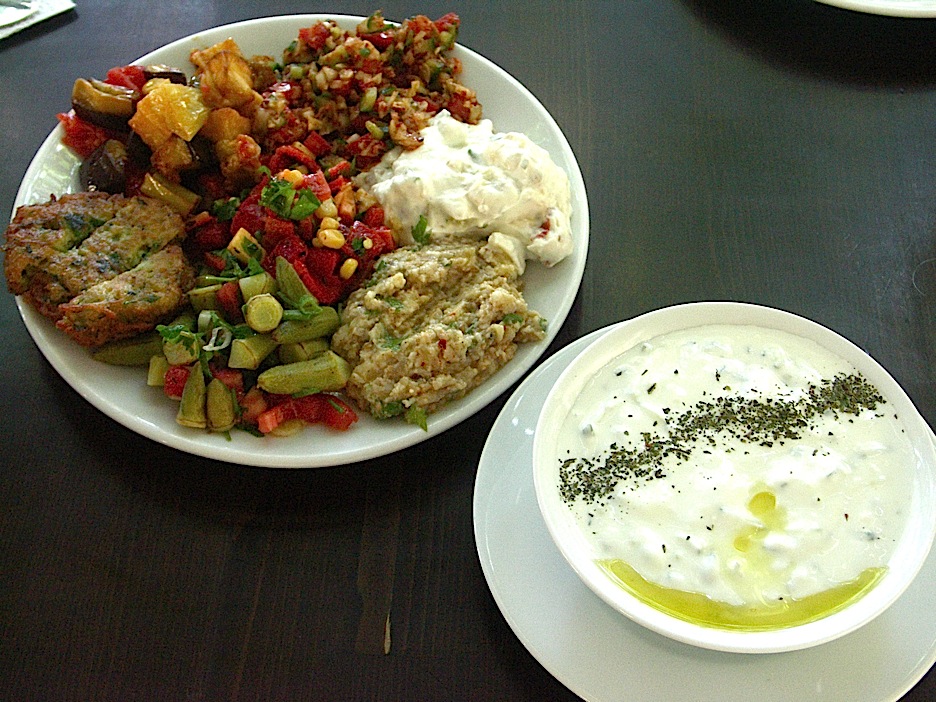 as they wish. But others
are very modern, including women like myself, who are
as interested in true democracy as anyone in Europe. For you
know, that is the age-old preoccupation of the Turks:
Are we Europeans or are we Asians? It is not a
question likely to be resolved soon.”
as they wish. But others
are very modern, including women like myself, who are
as interested in true democracy as anyone in Europe. For you
know, that is the age-old preoccupation of the Turks:
Are we Europeans or are we Asians? It is not a
question likely to be resolved soon.”
Meanwhile ports of call like
Kuşadasi rely on all the world’s people to support its
historic grandeur.
Tourism is a great leveler in that regard, and
places like Kuşadasi, not most people’s first choice
to visit in the Aegean, holds surprise after surprise
for its beauty and richness of character.
All photos (except the
Kusadasi harbor and mosque) by Galina
Stepanoff-Dargery.
❖❖❖
NEW YORK
CORNER
Brasserie Pushkin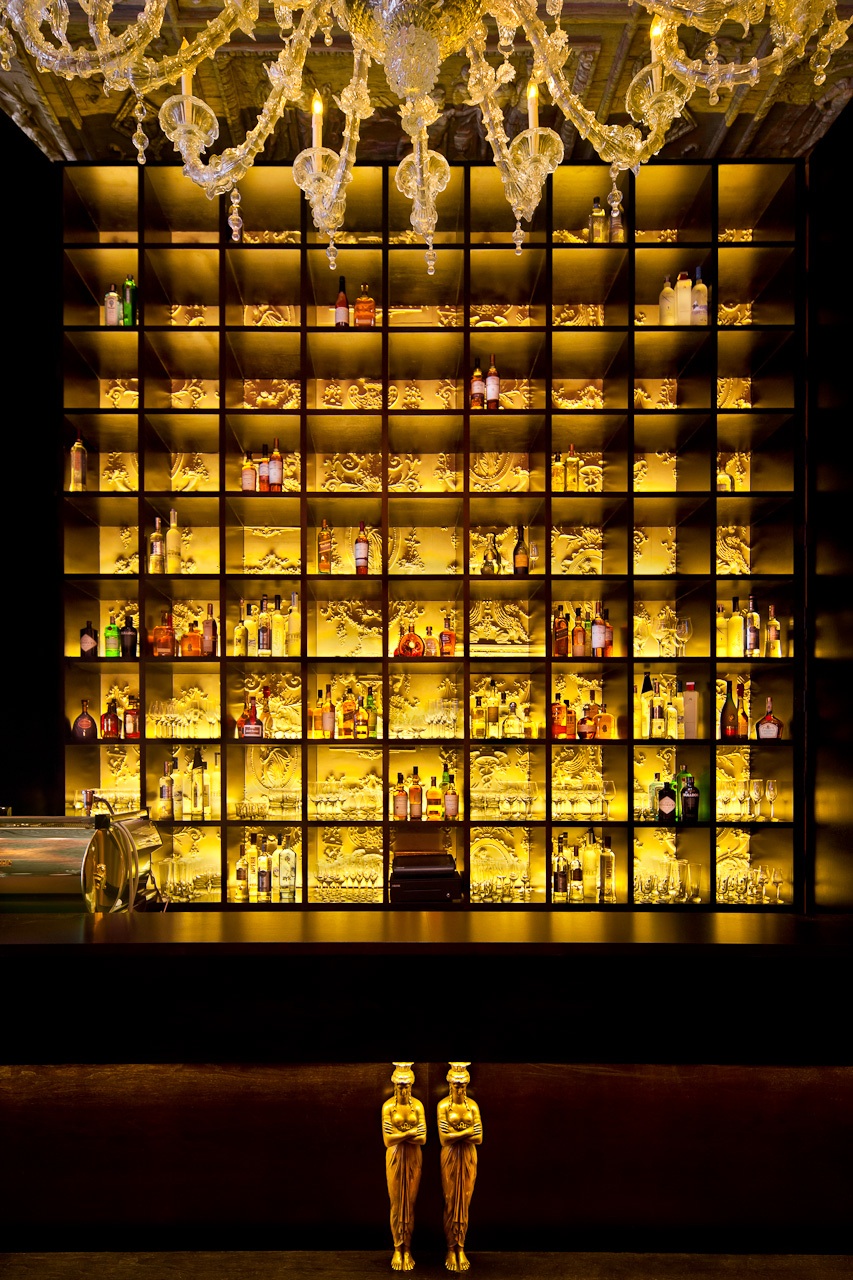
41 West 57th
Street (near Fifth
Avenue)
Photos by Francesco Tonelli
Syrnikov's contentions don't really amount to much in the real world of Russian cuisine. For to take potatoes out of Russia one might as well take them out of all European cuisines, remove tomatoes from Italian cuisine and chile peppers from all of Asia, because all those foods and more entered the world's larders via the Americas in what was called the post-1492 Columbian Exchange. His rant reminds me of the old Russian proverb, "If the poor did not provide the food, the rich would have to eat money." High class Russian food is just as Russian as that of the commoners.
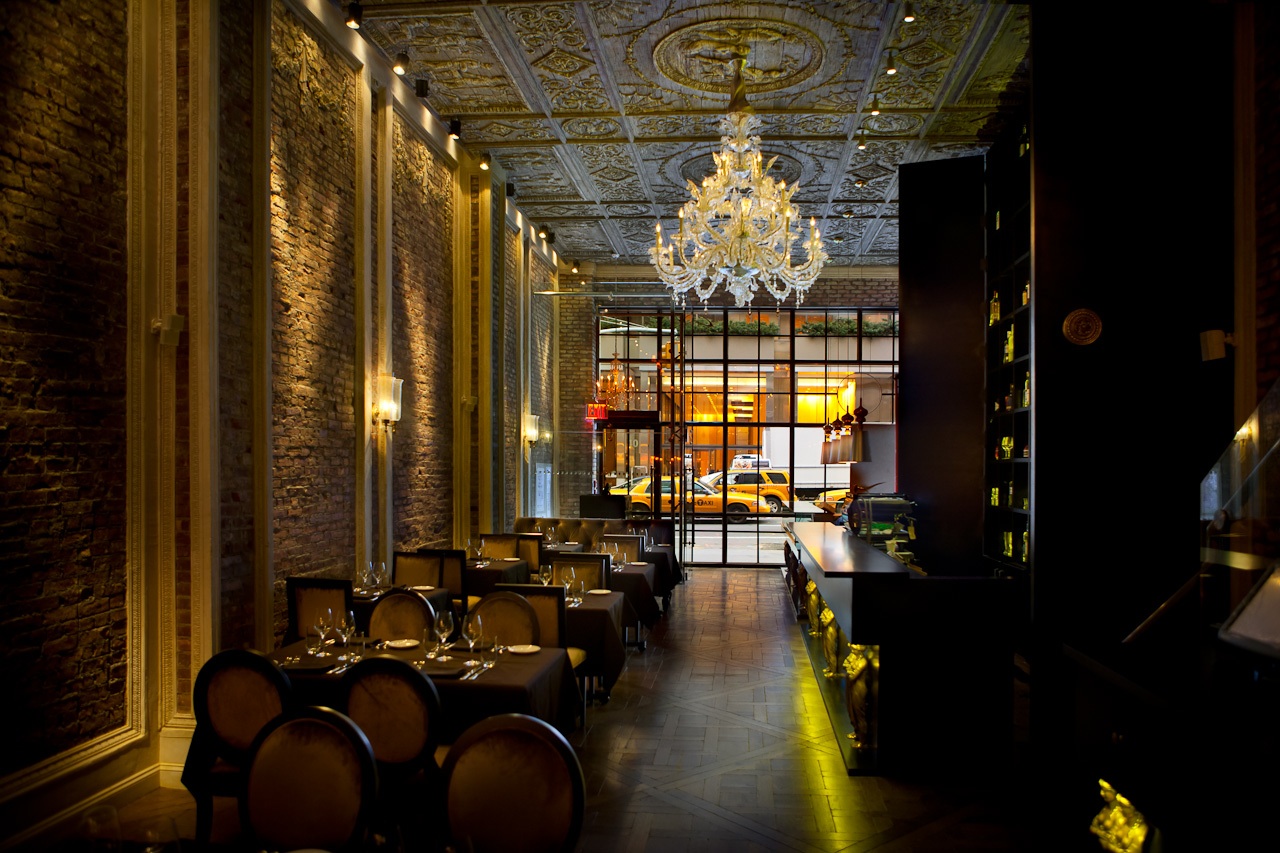 It is, however, well worth noting that
the food served in cities like Moscow and St. Petersburg
in Tsarist Russia was
heavily influenced by French cuisine, whose impact on
all the aristocratic courts of Europe was enormous.
French was the language of the Russian court. Even
a dish of raw, seasoned beef called "beef tartare,"
which only appeared in Paris restaurants in the last
century, has nothing to do with the cooking of the
nomadic Turkic people called Tatars. So it's natural
that so many French-style dishes would appear on Russian
restaurant menus, which tend to be festive and
celebratory, as it is today, Russian Orthodox Easter,
when, after midnight Mass, Russian break their Lenten
fast with meats and other rich foods.
It is, however, well worth noting that
the food served in cities like Moscow and St. Petersburg
in Tsarist Russia was
heavily influenced by French cuisine, whose impact on
all the aristocratic courts of Europe was enormous.
French was the language of the Russian court. Even
a dish of raw, seasoned beef called "beef tartare,"
which only appeared in Paris restaurants in the last
century, has nothing to do with the cooking of the
nomadic Turkic people called Tatars. So it's natural
that so many French-style dishes would appear on Russian
restaurant menus, which tend to be festive and
celebratory, as it is today, Russian Orthodox Easter,
when, after midnight Mass, Russian break their Lenten
fast with meats and other rich foods.All of this is worth keeping in mind when you visit the extravagantly decorated, new Brasserie Pushkin, with its huge chandeliers, carved moldings and ceilings, polished inlaid wood floors, gorgeously lighted bar (above), and Russian motifs that date back to the 19th century and the Beaux Arts era. (The drab brown tablecloths are hardly what you'd call festive, though.) The only thing out of synch is the playing of American jazz music rather than Russian, but that might be for the better. Otherwise, civilized conversation, even of the romantic kind, is happily possible.
You are greeted warmly by a bevy of beautiful Maria Sharapova-lookalike hostesses; the staff, some of whom are Russian, is cordial if as yet still on a learning curve for American dinner service. The management and waiters spend way too much time convening at the bar or in front of the computer, their backs to their guests, but I trust this will be corrected soon enough. Currently, Moscow chef Andrey Makhof is on premises to train a largely American kitchen, led by chef de cuisine Jawn Chasteen. When Makhof and the other Russians now employed here
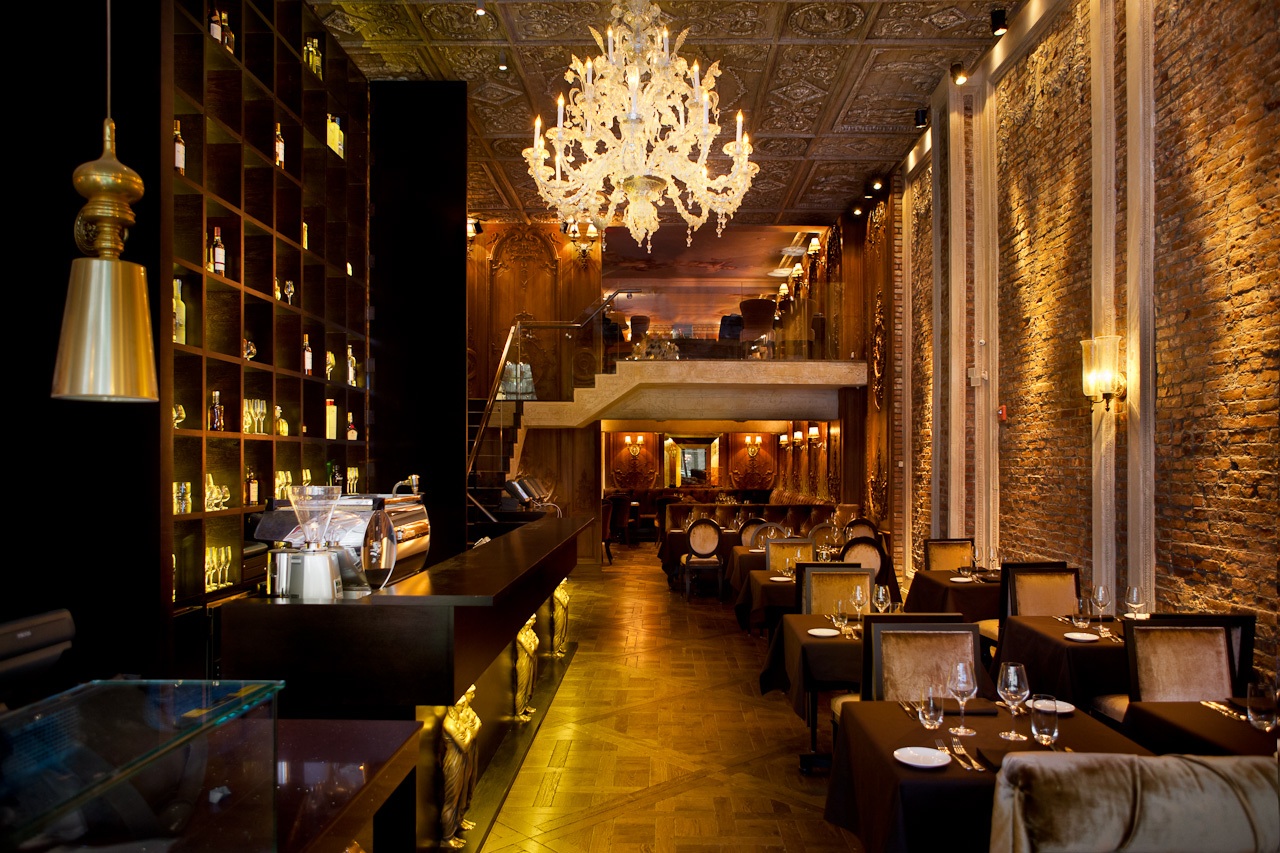 return to Moscow is anybody's
guess but I was told they are due to leave at some
point.
return to Moscow is anybody's
guess but I was told they are due to leave at some
point.Brasserie Pushkin is owned by One Percenter Moscow restaurateur Andrey Dellos, who has several similar restaurants in Russia and one in Paris, as well as a large chain of fast food eateries called Mu-Mu. He has, obviously, spared no expense in making the NYC operation (most likely a prototype for more to come) his showcase, and its location just east and across the street from that venerable NYC landmark The Russian Tea Room (1927) seems calculated to show that Russian cuisine can be highly refined yet retain its lusty links to the past. (It should be noted that many of the same items, at more or less the same prices, appear on both restaurants' menus.)
The menu comes as a folded broadsheet on brown paper, with old prints (and a few lame Russian jokes and antiquated historic notes) of dishes, pots and pans. It's a lavish screed, and there are plenty of delicacies here you won't find elsewhere in NYC. Of five salads offered, we tried the "vinegret," with beets, pickled cucumbers, potatoes, carrots, and cabbage, very hearty, generous, and delicious.
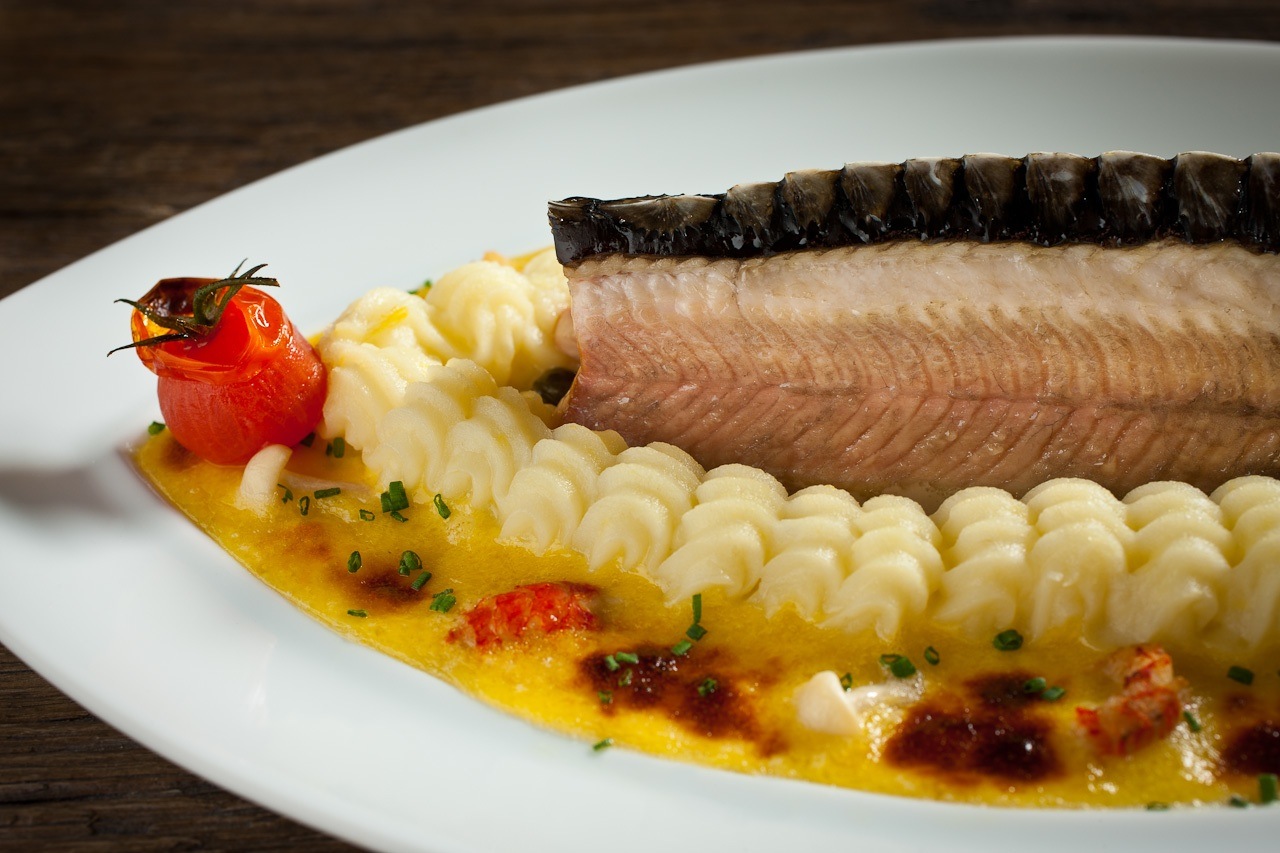 Among the appetizers is one of the finest
beef tartares I've ever had--impeccably fresh beef,
chopped to just the right mince, well seasoned and mixed
with quail egg on a crouton. Tuna tartare would
have been its equal had the horseradish foam not been so
tame--which is always the demerit of a foam sauce.
Among the appetizers is one of the finest
beef tartares I've ever had--impeccably fresh beef,
chopped to just the right mince, well seasoned and mixed
with quail egg on a crouton. Tuna tartare would
have been its equal had the horseradish foam not been so
tame--which is always the demerit of a foam sauce. My wife, Galina, who is two-thirds Russian, had to admit that the buckwheat blinis were excellent, feathery light, with a good buckwheat flavor, topped with crème fraîche (the fancy French name for sour cream), eggs, chives, and salmon roe (or, for $135, with osetra caviar). Stickler though she is, Galina also nodded vigorous assent as to the ideal texture and taste of the pelmeni, a kind of Russian ravioli stuffed with pork, beef and lamb.
Among the entrees, I was particularly delighted with chicken pojarsky, a breaded cutlet that may often come off as heavy and dense. Here it is as fluffy and juicy as a well-wrought omelet, light and very flavorful. Blintzes, which most New Yorkers will associate with heavy Jewish deli food, show themselves here to be refined, with a crispy skein of dough wrapped around succulent braised veal, with crème fraîche.
Among the four seafood entrees, sterlet (above), a small species of sturgeon, is served whole to retain its juices, accompanied by piped potato puree, baked cherry tomatoes, and a lush crayfish sauce (curiously enough, here spelled "crawfish," Louisiana-style). Also pristine in its whiteness was Casco Bay cod that took on a touch of sweetness from an apple-rosemary puree, Brussels sprouts leaves. and a fine reduction of Muscat wine.
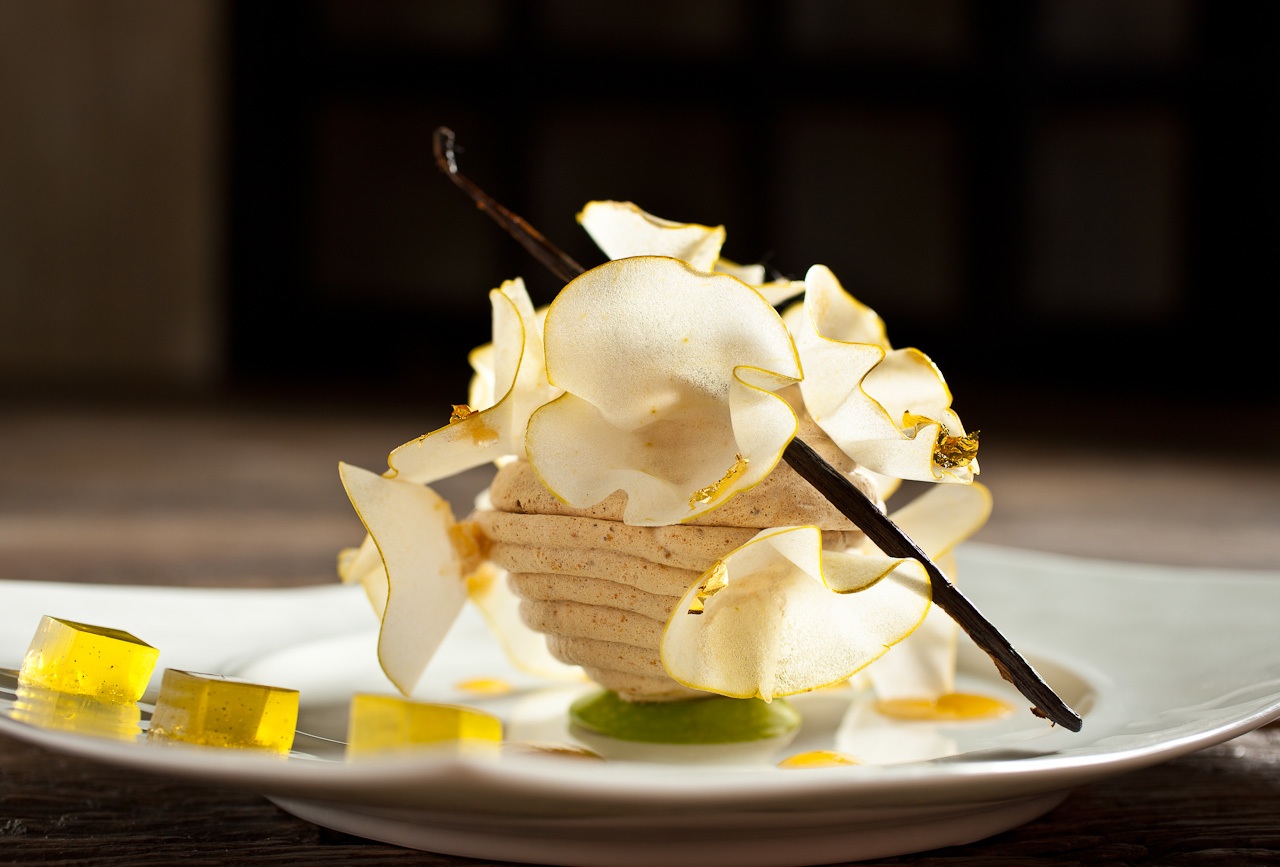
Desserts are intentionally lavish but oddly don't come up to modern standards. "Café Pushkin" is the name given to an old-fashioned layer cake with blueberry and raspberry jellies, toasted almonds, raspberry sorbet (too firm), pistachio mousse and a vanilla-orange coulis--a dish too fussy and too fussed with. A hazelnut meringue dome (right) with ice cream filling, saffron-apple marmalade and sheer sheets of apple is a reminder of why baked Alaska went out of fashion, and the profiterole was one big softball of puff pastry sandwiching praline-coriander ganache with a chocolate lime sauce--the kind of over-the-top presentation that might make you think Russian food is a bit on the excessive side.
For a new restaurant, the wine list has immediate heft, depth and breadth, but it is astonishingly top heavy in very high end bottles, with few whites below $75 and few reds under $100. A bottle of Château Montrose '05 will run you $135 at a store; here it's $545. Patz & Hall Pisoni '08 runs $60 retail, here $208. Flowers Camp Meeting Ridge '08 is $60 versus $164. There are a number of specialty cocktails and house-infused vodkas.
Brasserie Pushkin should evolve into a real enchantment when everything hangs together and comes into focus. It's beautiful, it's fun to be there, and the food can be enlightening about what Russian cuisine once was and now is again.
Open daily from
❖❖❖
Calming Down Those
California Pinot Noirs
by John Mariani
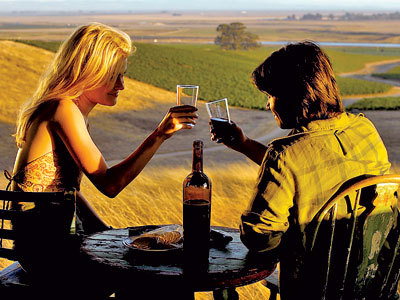
Rachael Taylor and Freddy Rodriguez in "Bottle Shock" (2008)
Indeed, it would be a rare thing to find any of the great pinot noir-based wines of Burgundy at anything like those levels: Romanée-Conti, one of the richest (and most expensive) Burgundies, usually hits 13 percent. Any wine, red or white, must have its alcohol by volume printed on its label, though the bottle may in fact contain, by law, plus or minus one percent for wines over 14 percent, and there are tax penalties for underestimating those levels.
Still, those monster California pinots (Oregon pinots tend not to be so massive) gather accolades and awards, sometimes allocating their wines through subscription. Finesse and balance are not their strong points. High prices are.
I have always been an admirer of the pinot noirs of Williams Selyem, whose wines stay between 13.8 and 14.1 most years, although they’ve made some whopping big chardonnays and zinfandels that break the 16 percent ceiling. Increasingly I have been drinking with pleasure a range of California pinot noirs below 15 percent, and they haven’t the high price tags of their brawnier competitors’. Here are some I’ve enjoyed recently, all under 14 percent.
Forest Glen Pinot Noir 2010
($8)—Very easy to drink, at 12.8 percent, with very
soft tannins and tangy acids. It’s actually made
from 80 percent pinot noir and 20 percent syrah to
give it more berry flavors. The regional vineyards
are not specified on the label. Not a great deal of
depth here, but for eight bucks it will go well with
a club sandwich or grilled salmon.
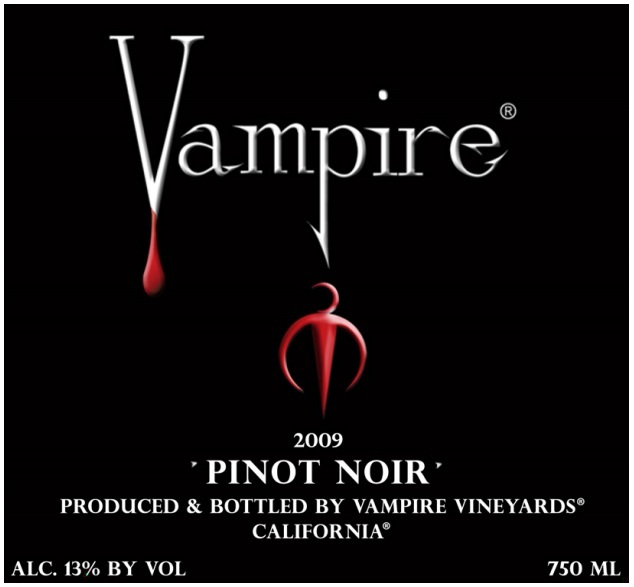
Vampire 2009
($13)—The silly name tends to put off wine snobs, as
can its website that reads “rumor has it that
Vampire Vineyards are actually owned by a circle of
vampires,” along with a company founder who’s an
“entertainment lawyer from New York.” Still, while
no one would call this pinot noir complex, it has a
good strawberry nose and a hint of that “barnyard”
taste pinot noir fanciers love. With 12.5 percent
alcohol, it’s a lightweight that makes it a fine
choice for veal or pork dishes, even fresh tuna
cooked rare.
DeLoach Heritage Reserve 2009
($13—This Russian River Valley example—a region from
many of the best California pinot noirs now
come--begins on the palate with plenty of fruit,
clean, fresh, at 13.5 percent alcohol, and with true
pinot noir flavor of a kind bigger examples
obliterate. DeLoach (below) prides itself on still
using the old punching-down technique in the wine
vats called pigéage
in Burgundy. Not a long finish but it’s rich enough
to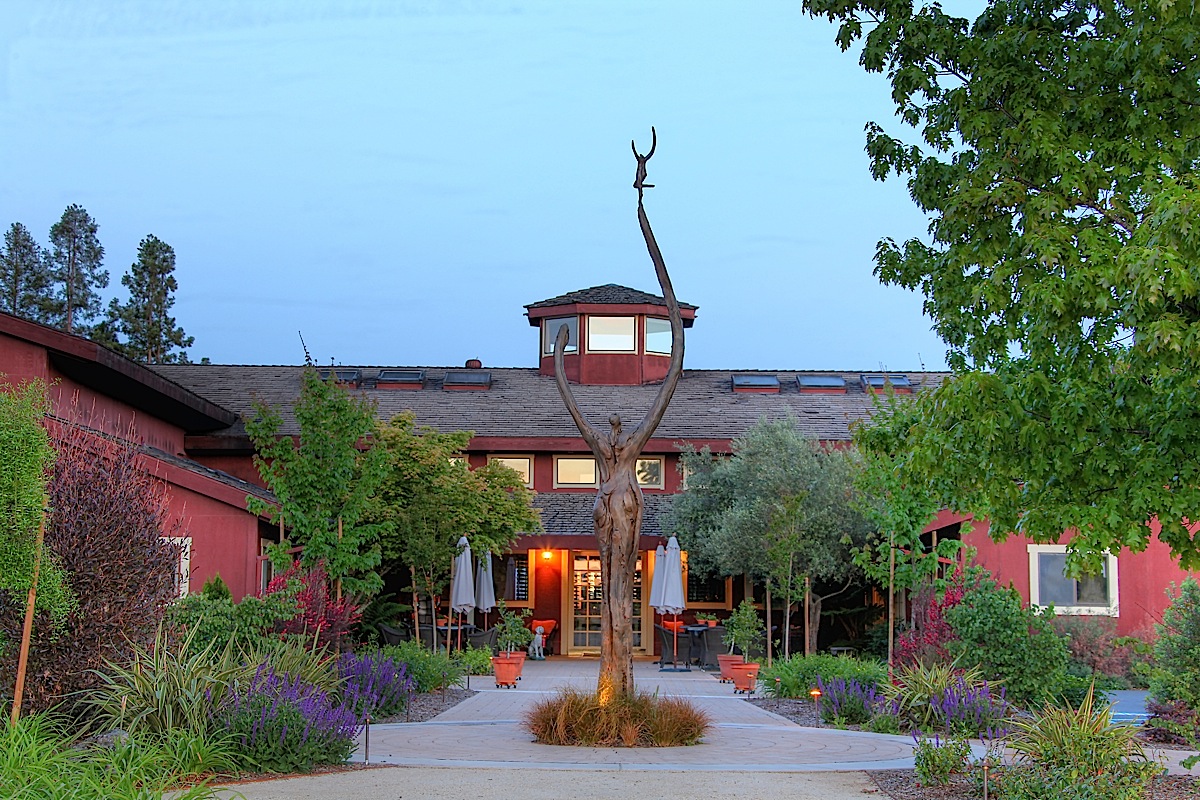 go with
roast lamb or any chicken dish imaginable.
go with
roast lamb or any chicken dish imaginable.
MacMurray Ranch 2009
($18)—There are violets in the nose, typical of fine
pinot noir, and this Sonoma Valley bottling has both
the body and spice that define the better aspects of
sunny California pinot noirs from cooler terroirs.
I’d happily drink it with smoky pork or a pasta dish
with wild mushrooms.
Coppola Silver Diamond Label
Monterey
2009 ($18)—The price is certainly right for this
example from Monterey County’s Santa Lucia
Highlands. It is bold and complex, with a sweet
undertone you rarely find in Burgundian examples.
It’s one of those rare pinot noirs that will 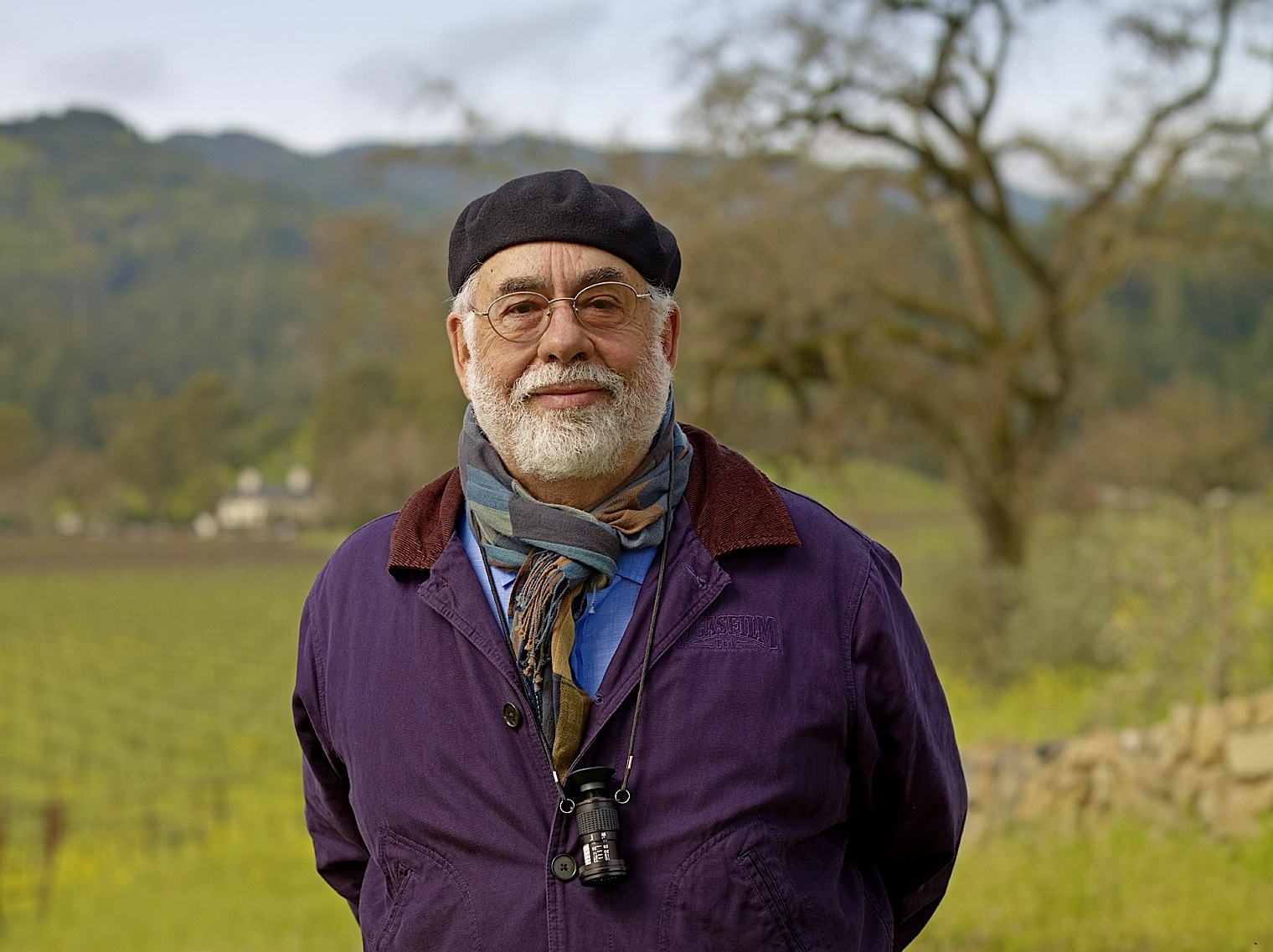 go with tomato sauces,
which I suspect winemaker and sometimes filmmaker
Francis Ford Coppola (left) had in mind all the
time. The website also recommends it with take-out
Chinese.
go with tomato sauces,
which I suspect winemaker and sometimes filmmaker
Francis Ford Coppola (left) had in mind all the
time. The website also recommends it with take-out
Chinese.
Ramspeck Napa Valley 2009
($17)—A wonderful bouquet that flourishes into a
wine with some tight tannins, this will take on the
char of a steak grilled outdoors as well as game
dishes come this autumn.
Angeline Reserve 2010
($17)—This is an interesting blend of pinot noirs,
36 percent from Sonoma, 34 percent from Mendocino,
and 30 percent from the cooler Santa Barbara, all of
which comes together in admirable balance, not least
in the acids that underpin and refresh the tannic
qualities. This one has some of that plummy
character those who love big-fisted wines crave, and
I’d as soon serve it with cheese like
Parmigiano-Reggiano or a fine Cheddar as I would
with the sweet flavors of Chinese food like Peking
duck.
❖❖❖
 WHEW!!
WHEW!!
"CORRECTIONS:
A report last Wednesday in the Off the Menu column
rendered incorrectly the name of a food and music
festival planned for Prospect Park, Brooklyn, in
May. It is The Great GoogaMooga, not The Great Googa
Mooga."--NY Times.
THEY CALL THEM "HAPPY MEALS"?

According to scientists
from the
University of Las Palmas de Gran Canaria and the
University of Granada, there is a
direct relationship between eating fast food or
commercial baked goods (doughnuts, cakes,
croissants) and the risk of developing depression,
with fast food fans 51 percent more likely to
develop depression than minimal or non-consumers.
Also, results of the study indicated that those who
ate the most fast food and commercial baked goods
were more likely to be single, less active and have
poor dietary habits, as well as smoke and work over
45 hours per week.
Any of John Mariani's
books below may be ordered from amazon.com.
 |
My latest book, which just won the prize for best book from International Gourmand, written with Jim Heimann and Steven Heller, Menu Design in America, 1850-1985 (Taschen Books), has just appeared, with nearly 1,000 beautiful, historic, hilarious, sometimes shocking menus dating back to before the Civil War and going through the Gilded Age, the Jazz Age, the Depression, the nightclub era of the 1930s and 1940s, the Space Age era, and the age when menus were a form of advertising in innovative explosions of color and modern design. The book is a chronicle of changing tastes and mores and says as much about America as about its food and drink.
“Luxuriating vicariously in the pleasures of this book. . . you can’t help but become hungry. . .for the food of course, but also for something more: the bygone days of our country’s splendidly rich and complex past. Epicureans of both good food and artful design will do well to make it their coffee table’s main course.”—Chip Kidd, Wall Street Journal.
“[The menus] reflect the amazing craftsmanship that many restaurants applied to their bills of fare, and suggest that today’s restaurateurs could learn a lot from their predecessors.”—Rebecca Marx, The Village Voice. |
"Eating Italian will never be the same after reading John Mariani's entertaining and savory gastronomical history of the cuisine of Italy and how it won over appetites worldwide. . . . This book is such a tasteful narrative that it will literally make you hungry for Italian food and arouse your appetite for gastronomical history."--Don Oldenburg, USA Today. "Italian
restaurants--some good, some glitzy--far
outnumber their French rivals. Many of
these establishments are zestfully described
in How Italian Food Conquered the World, an
entertaining and fact-filled chronicle by
food-and-wine correspondent John F.
Mariani."--Aram Bakshian Jr., Wall Street
Journal.
"Equal parts
history, sociology, gastronomy, and just
plain fun, How Italian Food Conquered the
World tells the captivating and delicious
story of the (let's face it) everybody's
favorite cuisine with clarity, verve and
more than one surprise."--Colman Andrews,
editorial director of The Daily
Meal.com. "A fantastic and fascinating
read, covering everything from the influence
of Venice's spice trade to the impact of
Italian immigrants in America and the
evolution of alta cucina. This book will
serve as a terrific resource to anyone
interested in the real story of Italian
food."--Mary Ann Esposito, host of PBS-TV's
Ciao
Italia. "John Mariani has written the
definitive history of how Italians won their
way into our hearts, minds, and
stomachs. It's a story of pleasure over
pomp and taste over technique."--Danny Meyer,
owner of NYC restaurants Union Square Cafe,
Gotham Bar & Grill, The Modern, and
Maialino.
|
 |
 |
 |
 |
 |
 |
 |
 |
 Everett Potter's Travel Report:
Everett Potter's Travel Report: 
 Eating Las Vegas
is the new on-line site for Virtual Gourmet
contributor John A. Curtas., who since 1995
has been commenting on the Las Vegas food
scene and reviewing restaurants for Nevada
Public Radio. He is also the
restaurant critic for KLAS TV, Channel 8 in
Las Vegas, and his past reviews can be
accessed at KNPR.org.
Click on the logo below to go directly to
his site.
Eating Las Vegas
is the new on-line site for Virtual Gourmet
contributor John A. Curtas., who since 1995
has been commenting on the Las Vegas food
scene and reviewing restaurants for Nevada
Public Radio. He is also the
restaurant critic for KLAS TV, Channel 8 in
Las Vegas, and his past reviews can be
accessed at KNPR.org.
Click on the logo below to go directly to
his site.

Tennis Resorts Online: A Critical Guide to the World's Best Tennis Resorts and Tennis Camps, published by ROGER COX, who has spent more than two decades writing about tennis travel, including a 17-year stretch for Tennis magazine. He has also written for Arthur Frommer's Budget Travel, New York Magazine, Travel & Leisure, Esquire, Money, USTA Magazine, Men's Journal, and The Robb Report. He has authored two books-The World's Best Tennis Vacations (Stephen Greene Press/Viking Penguin, 1990) and The Best Places to Stay in the Rockies (Houghton Mifflin, 1992 & 1994), and the Melbourne (Australia) chapter to the Wall Street Journal Business Guide to Cities of the Pacific Rim (Fodor's Travel Guides, 1991).


The Family Travel Forum - A
community for those who "Have Kids, Still Travel" and
want to make family vacations more fun, less work and
better value. FTF's travel and parenting features,
including reviews of tropical and ski resorts, reunion
destinations, attractions, holiday weekends, family
festivals, cruises, and all kinds of vacation ideas
should be the first port of call for family vacation
planners. http://www.familytravelforum.com/index.html
ALL YOU NEED BEFORE YOU GO


MARIANI'S VIRTUAL GOURMET
NEWSLETTER is published weekly. Editor/Publisher: John
Mariani.
Contributing Writers: Christopher Mariani, Robert Mariani,
John A. Curtas, Edward Brivio, Mort Hochstein,
Suzanne Wright, and Brian Freedman. Contributing
Photographers: Galina Stepanoff-Dargery,
Bobby Pirillo. Technical Advisor: Gerry McLoughlin.
© copyright John Mariani 2012
